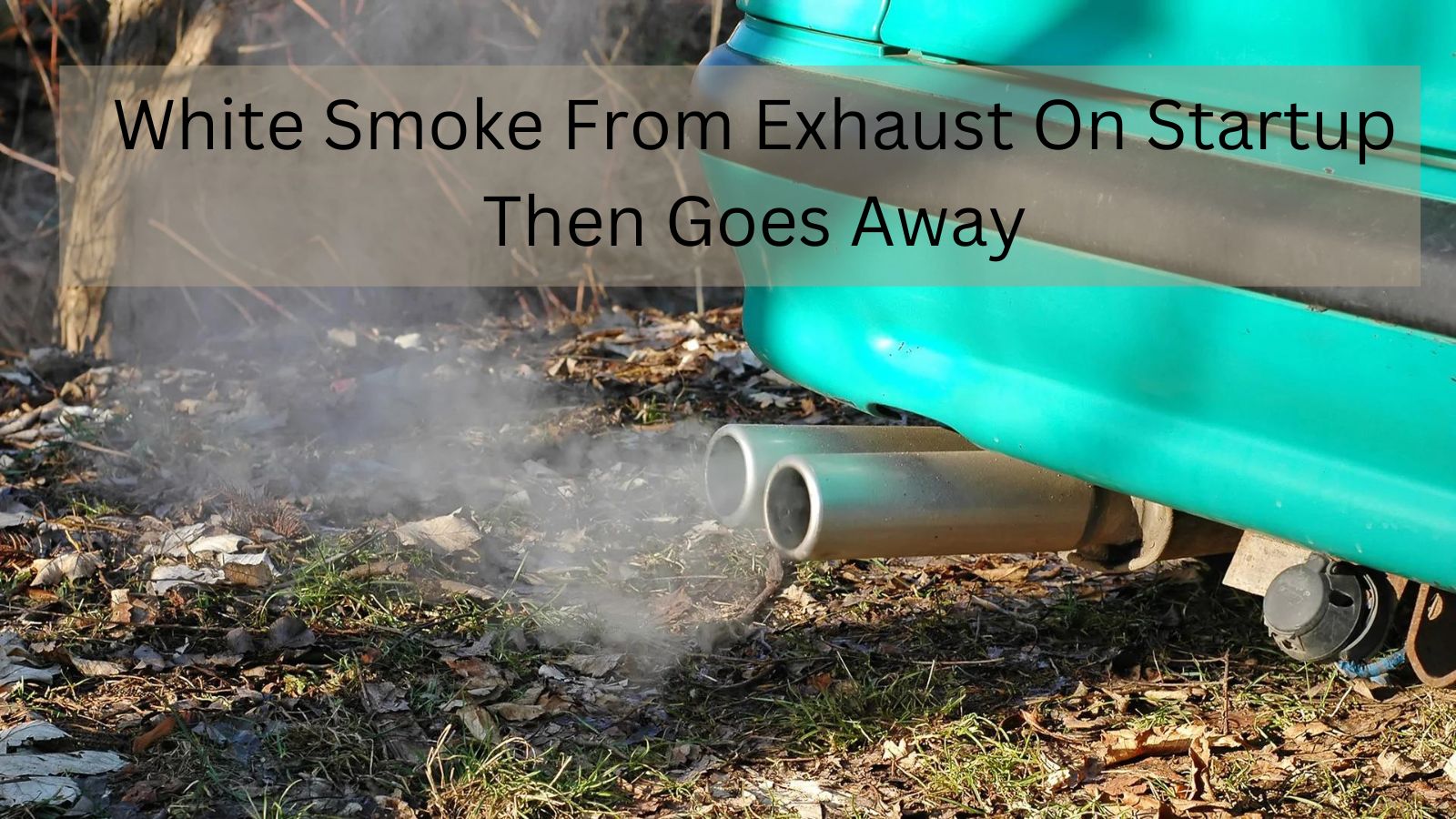Your vehicle’s exhaust pipe is an important component that removes harmful gasses from your engine’s internal combustion process. There are many reasons why white smoke from exhaust on startup then goes away.
In most cases, especially during the winter, some white smoke coming out of the exhaust is perfectly normal and nothing to worry about.
But other causes can also be a cause for concern. And you should not ignore them. A common occurrence is a white smoke from the exhaust being expelled in thick puffs. Never ignore this and let it drag on.
The most common reasons for this to occur are cracks in major engine parts, including damage to the cylinder head, head gasket, or engine block. What does the white smoke from the exhaust mean when you start and then disappear?
Below are the most common causes of white exhaust smoke discussed by our experts at my nice cars, and you’ll find how to fix and treat each culprit.
What Is the Meaning of White Smoke From Exhaust?
White smoke coming from the exhaust of a vehicle typically indicates that there is coolant or water entering the combustion chamber and being burned along with the fuel. This could be a sign of several potential issues, such as a blown head gasket, a cracked cylinder head, or a cracked engine block.
When coolant or water enters the combustion chamber, it vaporizes and produces the white smoke seen coming from the tailpipe. It’s important to address this issue promptly as continued driving with a coolant leak can lead to engine damage and overheating.
If you notice white smoke coming from your exhaust, it’s advisable to have your vehicle inspected by a qualified mechanic to diagnose and repair the underlying problem.
Reasons Why White Smoke From Tailpipe On Startup Then Goes Away
If you find yourself in an unfortunate situation where white smoke keeps coming out of the exhaust after letting your car warm up for more than a few minutes. Then you could have internal problems.
Certain reasons for this are minor and can be easily fixed without any complications. However, there are other reasons for white smoke from exhaust on startup that then goes away that are much more serious and may lead to other problems in the future.
1. Condensation Buildup
Fine white smoke that disappears on startup is usually the result of condensation in the exhaust system. It occurs mainly in winter or on cold mornings.
The smoke should be thin and not too visible, coming out in small amounts at startup and burning off fairly quickly after the engine warms up, especially after about 30 seconds to a minute.
It is not an indication of a problem, but it does occur in conjunction with other instances of reduced engine performance or difficulty starting.
2. Cracked Cylinder Head
Any time the cylinder head is cracked or damaged, coolant will begin to leak. It doesn’t have to be a big crack either. It is enough that some coolant escapes and mixes with the engine oil.
Once that happens, the oil becomes contaminated. The first sign of dirty oil is white smoke from the exhaust upon starting and then disappearing.
3. Coolant leak
If you see white smoke coming out of the exhaust when starting, after the engine has already warmed up and you’ve been driving for a few minutes, then this is a sign that you may have a coolant leak in one of the pipes or in the engine of your car.
If coolant leaks, the engine cannot cool itself or lubricate parts properly, causing overheating and excessive response.
4. Damaged Head Gasket
If the cylinder head gasket is damaged or cracked, coolant can leak into the combustion chambers or vice versa. This can cause the engine to burn coolant and, depending on the size of the leak, produce thick white smoke from the exhaust.
Unfortunately, repairing a blown cylinder head gasket is often very expensive as many parts have to be disassembled to replace them.
5. Oil Leak
If oil ever leaked from the piston rings or valve seals, it would flow into the internal combustion chamber along with the fuel. As soon as the fuel and oil are mixed, it comes out of the exhaust pipe.
You will likely see a bluish smoke coming from your exhaust, but it may look like white smoke to some people.
6. Wrong Fuel Type
If you have mis-fuelled your car, it can often result in white smoke from the exhaust on startup then goes away. This is because the wrong fuel does not burn properly and often creates a lot of smoke.
If you put the wrong fuel in your car, it is important to drain and refill it as soon as possible to avoid damaging the engine.
How to Fix?
Now you know the reasons why the white smoke from the exhaust. There are several methods to solve this annoying problem. Check out the best ways to fix:-
1. Check Coolant Level
If you want further proof that you have a problem with coolant leaking into the engine block when it should be contained, the first thing you should do is check the coolant level.
If you find that the level is low and you don’t see coolant coming out of the coolant reservoir, this supports the theory that the leak is due to a cracked head gasket, cylinder head, or engine block.
It is also recommended to invest in an engine block leak detection kit that uses chemicals to determine if your coolant is contaminated.
2. Perform Pressure Test
To determine if this is the problem, you can test the cooling system by performing a pressure test to determine if your engine is overheating or if you have a leaking head gasket.
To prevent white smoke from starting and accelerating, you may need to replace the leaking gasket to prevent future problems.
3. Inspect Valve Seals or Piston Rings
Piston rings and valve seals are subject to wear. If these fail, a replacement is announced. Unfortunately, as simple as the parts may seem, replacing piston rings is extremely expensive, typically costing between $1,800-$3,500, of which the parts are only $75-$200 and the rest is for the labor, as this is one is a very time consuming task. .
4. Inspect the intake gasket
There is a gasket on your car that seals the manifold to the head. The manifold and seal distribute the air-fuel mixture throughout the vehicle and transport the necessary coolant to the intake duct to cool the mechanism.
This intake port and the other ports are located in the cylinder heads; however, if any of these parts become damaged over time, coolant will leak into the port and combustion chamber.
FAQ
Q. 1) How long should white smoke last?
Ans. 1) It is more likely to occur in winter or on cold mornings. The smoke should be thin and not too visible, coming out in small amounts at startup and burning off fairly quickly after the engine warms up, especially after about 30 seconds to a minute.
Q. 2) Can I drive my car with white smoke?
Ans. 2) Thick white smoke could be a sign that there is a problem with the engine. It could be overheating and if so you should stop driving as soon as possible. You could seriously damage your vehicle if you decide to just ignore it.
If the smoke smells sweet, there is a problem with the coolant. However, if you smell fuel, there may be a problem with the fuel system.
Q. 3) How much does it cost to fix white smoke from exhaust?
Ans. 3) It varies, if it’s just a blown head gasket it will cost a few hundred dollars including labor, if it’s worse (say a cracked cylinder or blown head) it can cost thousands depending on the engine.
Conclusion
If you see white smoke coming out of your car’s exhaust pipe when you start the engine, it’s probably due to a coolant or oil leak.
However, there are other possible causes such as using the wrong fuel, bad injectors or even a blown head gasket. Since white smoke usually indicates larger problems, make sure you identify and fix the cause as soon as possible.


